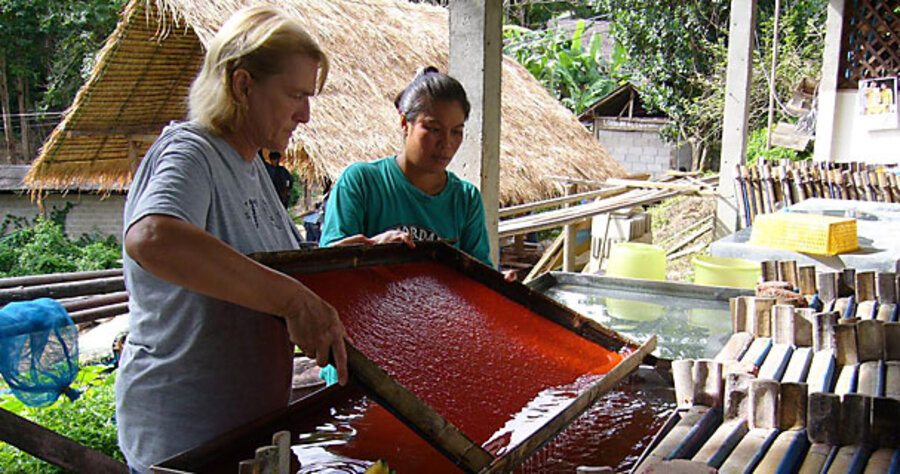Unorthodox papermaking helps a Thai elephant refuge
Loading...
| Chiang Mai, Thailand
Some people look at a pile of elephant dung and see a big waste-disposal problem. Wanchai Asawawibulkij looks at the same pile and sees ... paper. And a way to help elephants in his native Thailand.
The elephant is Thailand’s national animal and it holds a special place in the hearts of citizens. But the elephant population is dwindling here. According to the Tourism Authority of Thailand, there were 100,000 elephants in the country in 1900 and only about 4,000 today. Of these, only about 1,500 live in the wild, and their numbers are decreasing by 5 to 10 percent annually.
Throughout Thai history, elephants and humans have lived symbiotically. Many elephants were domesticated and used to log the once-abundant forests, ironically contributing to their own demise in the wild by destroying habitat. When the decimated forests became protected in 1989, many elephants were out of work and some lived in unhealthy conditions. Rescue and conservation centers were set up to help the elephants.
The Thai Elephant Conservation Center (TECC) here, founded in 1993, was formerly a timber organization that restructured itself “to provide work for our ex-logging elephants after the government banned logging in natural forests,” says TECC adviser Richard Lair. The TECC, located near the northern city of Chiang Mai, has since grown to help conserve elephant populations through ecotourism.
The resident elephants – most of them ex-loggers but some donated or born at the center – are taken care of and in return are trained to interact with tourists but only in ways that are beneficial to both the animals and humans.
Mr. Asawawibulkij used to spend his days as a paralegal in Bangkok but nurtured a desire to do something to “save nature and help the elephants,” he says. Along the way he became interested in handmade paper, a traditional Thai art. On a visit to the TECC he saw the vast piles of dung and the idea of making paper just came to him.
One must hasten to explain that the dung is washed and sanitized thoroughly. The elephant’s diet is mostly vegetation, much of it very fibrous, and most of which does not break down completely in the elephant’s gut. The mass of softened fibers is what makes elephant dung a papermaker’s dream.
Asawawibulkij spent two years perfecting the process, then quit his job and launched Elephant Dung Paper in 2001.
An elephant eats about 440 pounds of food each day, Asawawibulkij says. The 50 elephants at the center contribute almost three tons of dung daily. “Before,” he says in what surely must be an understatement, “we had a problem: how to manage the waste.”
The paper factory is a small operation located on a hill and surrounded by trees in the vast elephant center. The open-air business is spread out over a grassy lawn and under a covered work area. One of the first things a visitor notices are the many sheets of paper lined up to dry in neat rows in front of the building.
Asawawibulkij, a jovial, compact man with a permanent smile, explains that this papermaking process is as environmentally friendly as possible.
The dung is collected and boiled for five hours in a large vat. The fibrous heap that remains is then treated with hydrogen peroxide, an environmentally safe bleaching agent, according to the US Environmental Protection Agency. (The water is recycled on the garden.)
The sanitized fibers are put in a mechanical spinner until they’re the right consistency. Dye is added. After about three hours of spinning, the fibers are shaped into balls of a precise weight: Each ball will become a sheet of thick paper about 22 inches wide and 30 inches long. The fiber balls are added to water in a bucket, mixed well, then carefully spread onto a screen frame. The frames are left to dry in the abundant sunlight.
Once the paper is dry, souvenirs such as stationery, notebooks, and photo albums are made to be sold to visitors.
Bold tourists can help create the paper. On a recent visit, Australian Alison Foster dived into the task while her husband videotaped it. “The dung itself was soft, and dissolved in the water very quickly,” says Foster by e-mail. “It didn’t smell though, so after the initial reaction to it the rest of the process wasn’t too bad.” Sadly, she couldn’t bring any paper back home. “Customs didn’t allow us to bring it into Australia, as you are not allowed to introduce foreign seeds and grains to the country,” she says, and the paper does contain a few undigested seeds. “But we were happy that the money had gone to helping the elephants.”
Paper is not the only elephant-dung product here: Biogas and compost are made as well. The elephant mahouts (the trainers who stay with elephants for their entire lives) use the biogas to cook for themselves and overnight tourists.
The local community also benefits: Local villagers are employed to make the products, and they now earn a decent wage. The dung products bring in about $270,000 per year.
But the ones who benefit most are the elephants themselves. The dung factory calls it the “circle of conservation – elephants helping elephants.”
• Current TV has a video showing papermaking process. For more information, go to www.elephantdungpaper.com.





